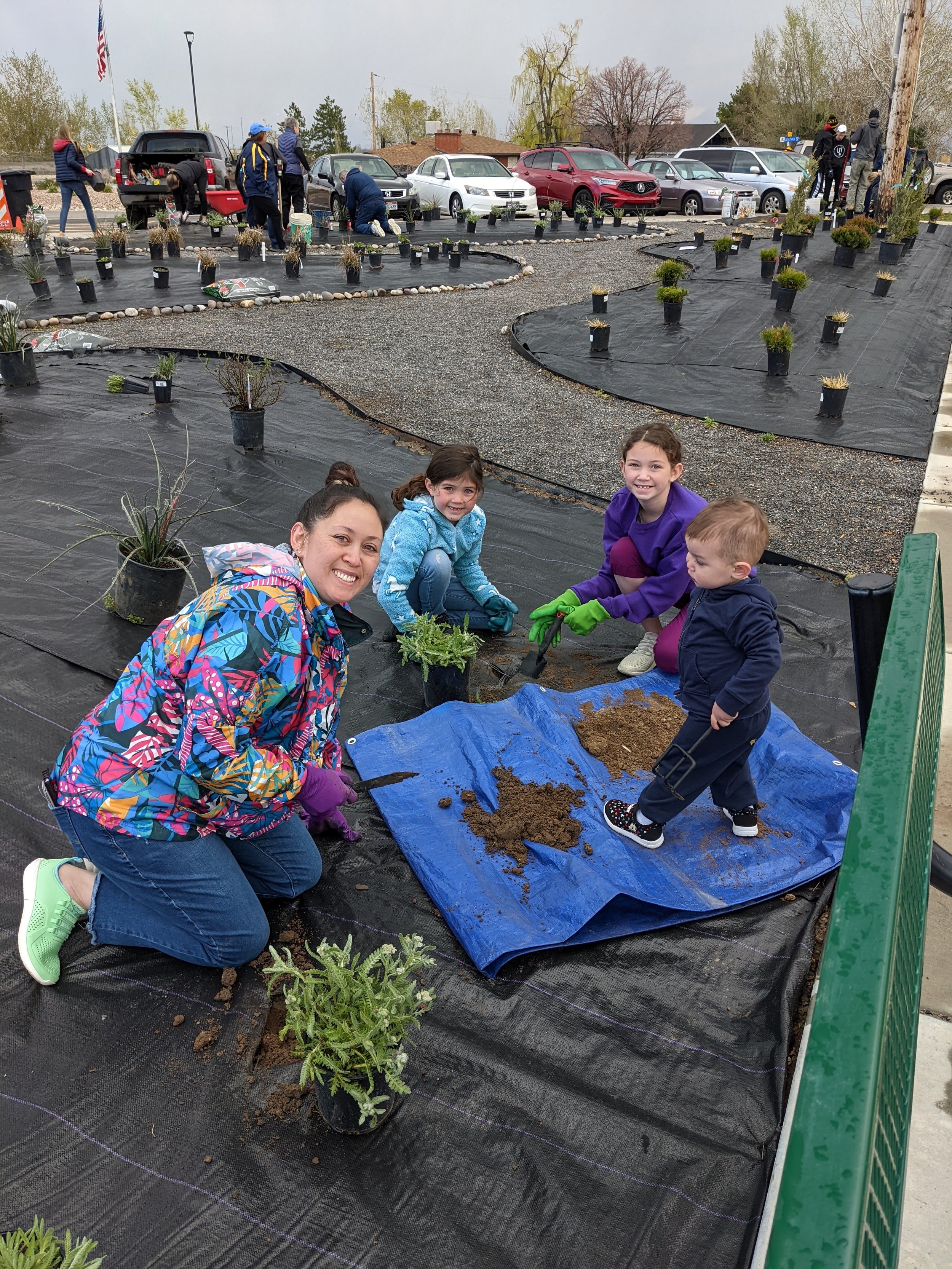ASLA UTAH APRIL 2022 NEWSLETTER
ASLA UTAH APRIL 2022 NEWSLETTER
UPCOMING EVENTS
LA’s GIRLS NIGHT OUT - RAIN BIRD
Tuesday, May 17th, 5:00pm - 7:00pm
Cactus & Tropicals, 12252 Draper Gate Drive, Draper Space limited to 25 - RSVP HERE
VICTOR STANLEY Live Virtual Learning Event 1.0 PDH (pending)
Thursday, May 12th, 12:00pm Instructor: Shawn T. Kelly, PLA, FASLA
REGISTER HERE
2022 ACEC Build Business Summit, May 12-13 Conference Center at Miller Campus 9750 S 300 W, Sandy ASLA UT gets member rate. More info: HERE
SAVE THE DATE!! ASLA Utah Annual Conference
September 8th & 9th
More Detail Coming Soon!
CALL FOR NOMINATIONS! ASLA UT Executive Committee Open Positions: Pres. Elect, Secretary, VP of Marketing/Visibility, VP of Membership. Contact: Jake Powell, jake.powell@usu.edu
CALL FOR ENTRIES ASLA Utah Professional Awards Entries due 5:00 pm Friday, June 24. CLICK HERE FOR MORE INFO
Leadership Express
Adam Castor, Chapter President
Spring is such a wonderful time in Utah! It is so refreshing to finally see the early season bloomers that don’t mind a few inches of snow and an overnight freeze, the variety of flowering trees and shrubs showing off vibrant pinks, whites, reds, and yellows, and the array of greens set off by emerging conifer trees and grasses of all kinds.
As landscape architects we are so fortunate to have projects that allow us to get out of the office and into the field to see our design work either becoming a reality or coming back to life after a winter of dormancy; to be able to design with plant materials and create spaces that can have such a profound impact on our human senses, through all of the seasons; to be able to engage the environments that make Utah such a special place.
In recognition of Frederick Law Olmsted’s 200th birthday and the profession of landscape architecture, Red Butte Gardens hosted a celebration of Olmsted’s influence here in Utah. David Hart, AIA Fellow, provided a history of the Utah Capitol building dating back to the late 1700s and into the 1800s and the involvement of John Olmstead in the development of the master plan for the capitol building site. David’s presentation also highlighted the changes made to Olmsted’s master plan by German architect Richard Kletting and the efforts to implement many of Olmsted’s early ideas back into the renovation of the site and the construction of new buildings. Cynthia Bee provided a presentation on Frederick Law Olmsted’s notable projects, writings, and career moves, as well as his influence on her work designing residential landscapes. This event was well attended and it was a great opportunity to showcase the profession of landscape architecture.
The executive- and sub-committees have been busy this month with celebrations for World Landscape Architecture Month and Fredrick Law Olmsted’s 200th birthday, organizing our call for professional awards nominees, and the USU student awards. In addition, we have made a call for nominees for the upcoming 2022 ballot. There are several positions open on the executive committee and plenty of opportunities to become a part of a subcommittee. Please consider adding your name to the ballot, or nominating someone that you feel would make a good addition to the Utah chapter.
Here is a look at what is happening nationally at ASLA:
Chapter Presidents Committee (CPC)
The spring CPC meetings are being held virtually on April 28th and 29th. The agenda for the spring meetings includes a variety of topics such as government affairs, an update on ASLA national from CEO Torey Carter-Conneen, ASLA presidential candidate speeches and questions, climate action committee, membership update, chapter strategic planning and discussion workshop, membership dues, and membership discussion workshop. The CPC meetings are sure to be information packed and will be attended by Utah chapter leadership.
Government Affairs Take Action - Olmsted Proclamation Introduced in Congress
This year, April 26 marks the bicentennial of the birth of Frederick Law Olmsted, the founder of American landscape architecture. To recognize this occasion and raise public awareness of the profession, ASLA urges you to ask your congressional representatives for their support on H. Res. 1013. This proclamation will not only recognize Olmsted for his many contributions, it will also help to educate the public on landscape architecture’s historical and present significance. It will serve as a reminder of the impact that design choices invariably have on community, opportunity, and equity. It only takes a moment to send a letter to your legislator. Take action today!
Honors and Awards Student Awards Call for Entries - Each year, the ASLA Student Awards honor the best in landscape architecture from around the globe. Submissions are welcome in General Design, Residential Design, Analysis and Planning, Urban Design, Communications, Research, Student Community Service Award, and the Student Collaboration Award. Award recipients receive featured coverage in Landscape Architecture Magazine, the magazine of ASLA, and in many other design and construction industry and general-interest media. Award recipients, and their clients will be honored at the awards presentation ceremony during the 2022 ASLA Conference on Landscape Architecture in San Francisco.
· Entry Registration Fees Due: Friday, May 13 by 11:59 pm PST. · Submission Deadline: Friday, May 23 by 11:59 pm PST
Professional Practice ASLA Affinity Partner Webinar: Land Kit - May 3, 2022, 11:00pm - INFO HERE
Join ASLA for a presentation to learn how Land Kit can help you create workflows that will speed up your 3D Modeling, Design, and Visualization processes and develop more efficient and fluid workflows. Chris Landau will present the features and opportunities offered by the landscape plugin Land Kit. Speaker: Chris Landau, Affiliate ASLA, Principal, LANDAU Design+Technology
Thank you to all of our sponsors and members for your continued support of the ASLA Utah Chapter. We appreciate all that you do and look forward to seeing you all at upcoming events.
Adam Castor, ASLA Chapter President
WLAM Service Project
Aaron Johnson, VP of Visibility & Public Affairs
Hello! I hope everyone is having a great World Landscape Architecture Month (WLAM)! As this month wraps up I wanted to give an update on how the Utah ASLA Chapter shared/celebrated the profession of landscape architecture.
On April 23rd (day after Earth Day) we joined the Taylorsville City and their Parks and Recreation Committee to plant over 350 native/water wise plants in a local Labrum Park in Taylorsville. The goal of the project was to identify areas where traditional turf grass could be replaced with water wise/native plant material while creating an identity for Taylorsville parks and educating residents on how to create water wise landscapes in their own yards. The project began as an idea back in 2019 and after a Covid-19 delay funding was secured by Taylorsville City and the Landscape Leadership Grant from the Jordan Valley Water Conservation District. Over the past year members of the community and Taylorsville Parks and Recreation Committee donated their time after work and on weekends to dig up grass, lay path edging, move dirt, pull weeds, install irrigation, and lay weed barrier fabric. All of which culminated in the April 23rd Loving Labrum Park activity where we battled the weather and uncertainty to create a beautiful place for residents to come and learn about our environment.
Live Earth sponsored the event by providing refreshments and donating their product to use on the plants! We were lucky enough to have the weather cooperate with us and only sprinkle on us for a few minutes (despite the predicted weather all week). Amazingly, we had close to 35-40 volunteers to come help! An amazing turn out considering the weather. This crew of amazing volunteers consisted of Taylorsville residents, Utah ASLA members, elected officials, youth council members, and anyone who drove by and wanted to help. Families of all ages helping, friends and neighbors, and new friends all joined together to sweat, work, laugh, and get muddy to help the community they loved. It was an amazing experience and one that I will not soon forget.
Thanks to all those who came and gave their support and volunteered their time! Huge thank you to Live Earth for sponsoring the event! As we go forward trying to make this world a better place, please remember, that change/impact begins with a simple idea. Anyone can make a difference.
USU LAEP Awards Banquet
Adam Castor, ASLA UT President
On Friday, April 15th the LAEP department at Utah State University held their annual awards banquet at the Logan Country Club where faculty and students were recognized for their outstanding work and achievements in landscape architecture. I had the opportunity to travel up to Logan to present the ASLA student awards, but I was invited to come up ahead of the banquet to visit the sophomore Analysis and Design studio and to sit in for the Friday speaker series featuring Billy Fleming. It was great to engage with the students and to see the team project that they were collaborating and working on, which would make an incredible improvement to the campus on the east side of the Fine Arts building.
The awards banquet was well attended by both faculty and students, as well as our Executive Director Jenny Sonntag and members from the Advancement Board. On behalf of the ASLA Utah chapter, I would like to congratulate all of the award nominees and winners. Here are the awards that were presented at the awards banquet:
Outstanding Sophomore: Mary Claire Jennings
Outstanding Junior: Corinne Bahr and Braya Robbins
Senior Faculty Medal: Hannah Hanks and Cooper Parson
Outstanding 1st Year Grad: Addison Martin
Outstanding 2nd Year Grad: Sam Johnson
Graduate Student Faculty Medal: Katelynn Hall and Lloyd Sutton
Outstanding Faculty Award: Todd Johnson
Olmsted Scholar Nominees: Nairobi Jimenez (undergraduate) and Lloyd Sutton (graduate)
Outstanding Students – every single LAEP student
ASLA Honor Award: Lloyd Sutton (graduate)
ASLA Merit Award: Derek Jenson (graduate)
ASLA Honor Award: Hallee Kinikin (undergraduate)
ASLA Honor Award: Nairobi Jimenez (undergraduate)
ASLA Honor Award: Nikki Holbrook (undergraduate)
An Homage to Frederick Law Olmsted on the Occasion of his 200th Birthday
Michael Timmons, Professor Emeritus, USU LAEP
It is a fool’s errand to attempt to convey the enormity of Olmsted in a brief essay, let alone in a course of landscape history. Sadly, those few lectures suffered by most landscape architects during their college education forms the extent of our awareness of his contributions. We know the story of Central Park; we can list a handful of his notable projects; we are aware of his letter to the NYC Board of Park Commissioners in 1858, offering his resignation as park designer and signed Messrs Olmsted and Vaux, Landscape Architects, which we take to be the first use of that title and the “birth of our profession”. We are also likely familiar with his poetic words outlining our profession first penned in Walks and Talks of an American Farmer in England, 1850, and later repeated in his letter to the Board of Commissioners of Central Park, May 20, 1858, upon his appointment as Architect-in-Chief:
“What artist so noble as he who, with far-reaching conception of beauty and designing power, sketches the outlines, writes the colors, and directs the shadows, of a picture so great that Nature shall be employed upon it for generations, before the work he has arranged for her shall realize his intentions!”
But to scratch beneath the surface is to gain an appreciation of a remarkable human being. My own discovery and fascination with Olmsted began with a move to Massachusetts to begin my professional career, and later, graduate studies. So often I would find myself wandering the paths of Boston’s Emerald Necklace, entranced by the vision and artistry of the man who had sculpted and planted this landscape a century earlier. My good fortune to enroll in a graduate school elective course at Harvard, 50 years ago was, I have to say, transformative. The course was entitled “Frederick Law Olmsted and the American Environmental Tradition”, and was taught by noted Olmsted scholar Albert Fein, who had published his book by the same title earlier that year.
Fein wove together the biographical threads of a career so unpredictable, it would defy the imagination of a most creative writer of fiction. From civil engineering apprentice, to clerk in a dry-goods store, to cabin boy on a steamer to China; from farmer to journalist to editor/co-owner of Putnam’s Monthly and co-founder of The Nation (the oldest continuously published weekly magazine in the United States); from author of numerous works chronicling his travels through England and the antebellum southern slave states, including The Cotton Kingdom, to designer and Architect-in-Chief of Central Park; from Executive Secretary of the pre-cursor of the Red Cross (US Sanitary Commission) serving Union Forces in the Civil War, to authoring the report of the Yosemite Commission to the Governor of California, outlining the purpose and value of what would later become Yosemite National Park; and from designing some 100 parks, to establishing an office with his two sons that would create over 6,000 planned/designed landscapes across North America. But perhaps more profound than this tangible chronology was the set of environmental and social values he infused into the fledgling profession that grew from his efforts. Fein’s course jolted me into a realization that Olmsted was about far more than creating pastoral landscape scenes.
One wonders, with his practical take on politics and ability to succeed in the face of extreme political bickering, what role he may have played if he were present among us today? Would his skill and savvy have been able to navigate the great rift that so bitterly divides us?
Public Lands and Open Space
As I walk the trails system above my home in Logan with my dog, (not coincidentally named Olmsted), I gaze across the valley reflecting on past, present, and future. While I enjoy a network of public parks and open spaces that would have been unimaginable in 1822, I wonder at the same time if we are forward-focused enough.
I note in the recent Earth Day issue of the Salt Lake Tribune, that Utah lost an estimated 713 square miles of natural and agricultural open space between 1982 and 2017 to development and urban sprawl driven by record levels of population growth. The article observes that nationally, a new study tallies a total of 68,000 square miles of vanished open spaces over that same time … larger than the entire land mass of the State of Florida. Olmsted would be urging us to be proactive in encouraging smart growth and preserving space for our grandchildren. He would be saddened at the deterioration of our national parks due to underfunding, and outraged at the push by our representatives to privatize public lands.
Global Environment
The catastrophic threat to our global environment would have been beyond his wildest nightmare, but the sustainable practices he followed, had they been embraced, may have prevented us from reaching our present situation. Olmsted would ask how a humankind so advanced that we can explore the solar system and look down on planet earth 1,000 miles below from a satellite window, allow our home to succumb to a spiral of self destruction? Indeed, the man who envisioned converting a landfill in Manhattan into a verdant green-lung serving 1.7 million souls would be urging us to forgo short-term comforts, suck it up, and move forward posthaste to salvage our very future.
Social Reform
To Olmsted, creating parks and open space was not an end in and of itself, but a means of improving quality of life for urban dwellers, particularly the poor:
“It is one great purpose of the Park to supply to the hundreds of thousands of tired workers, who have no opportunity to spend their summers in the country, a specimen of God's handiwork that shall be to them, inexpensively, what a month or two in the White Mountains or the Adirondacks is, at great cost, to those in easier circumstances.”
Prior to Central Park, Olmsted made journeys through the South, writing detailed commentary on general industry and life style. His keen observations and vivid descriptions of inhumane and unjust treatment of enslaved blacks were printed in journals in the largely oblivious northern states, and eventually bound as a series of books raising awareness of the cruel practice of slavery. Promoting a clear message that black lives mattered, would he think about continuing racial inequality 120 years after his own death?
Medical Care
In 1862, driven by a sense of moral obligation, he took a leave from ongoing work with Central Park to offer his services as Secretary of the US Sanitary Commission. His accounts from the battlefield detailing the horrific conditions being suffered by severely wounded and ailing troops, cried out for the provision of humane treatment and advances in scientific medicine. More broadly, he urged a greater responsibility of government and society in general to address issues of public health. What would he have said about a health care system 160 years later which, despite our great wealth as a nation, still cannot provide universal health care for all?
War
Serving the Union forces during the Civil War, he spoke of atrocities of war that should be unthinkable in 2022. What would a man who questioned how Northern and Southern brothers could be killing each other in 1862 think to see Russian troops slaughtering Ukranian brothers, sisters, and children 160 years later?
“The possession of arbitrary power has always, the world over, tended irresistibly to destroy humane sensibility, magnanimity, and truth”
On this, the bicentennial of his birth, I would encourage every landscape architect to venture on a pilgrimage to more fully understand the importance and relevance of his Olmsted’s work to our contemporary world and practice. A personal visit to some of his masterworks is unequaled as a means of gaining an appreciation of his true genius. A few years ago, I was privileged to undertake a brief internship at the Olmsted Center for Historic Landscape Preservation at Fairsted, Olmsted’s home and office in Brookline, Massachusetts, and now the Frederick Law Olmsted National Historic Site. Sitting at my desk in what was his bedroom, looking out the window at the Olmsted elm which had been planted around 1810 and around which he had designed his own domestic landscape, I could quite literally sense his spirit.
If you are unable to undertake a physical pilgrimage, I encourage reading either from his own works, or the excellent biography by Rybczynski, A Clearing in the Distance. For a jump start, I’d suggest a visit to the National Association for Olmsted Parks website at https://www.olmsted.org/the-olmsted-legacy/frederick-law-olmsted-sr and the website of the Frederick Law Olmsted National Historic Site https://www.nps.gov/frla/index.htm.
Lastly, consider how we, as landscape architects of the 21st Century, can pay homage to the wisdom of our founder 200 years after his birth. Are we promoting the well being of all levels of society through our work? Are we truly embodying sustainability in everything we do … every choice of materials from plant pallet to hardscape embodying low carbon footprint? Are we raising our voices, imbued with the wisdom and moral compass of Olmsted, to fight for the protection of our public lands, and to create democratic green spaces in the face of ever-increasing urbanization/suburbanization of our world?
Special Thanks to ASLA Utah Sponsors & Corporate Partners for their Support in 2021 and look forward to working with you in 2022!! Renew your Sponsorship Here
Platinum Sponsors
BioGrass | Rain Bird | Victor Stanley
Gold Sponsors
Belgard | Hunter/FX Luminaire |Live Earth Products
Silver Sponsors Ameristar | Anova | Chanshare Farms
Landscape Forms | LuckyDog Recreation | Omega II Fence System | Utelite
Bronze Sponsors
AMIAD | CES&R | Forms + Surfaces | GPH Irrigation | Garrett & Company Graber/MADRAX Manufacturing | Hess Pumice | IRONSMITH | Miller Companies | Musco Netafim | PlaySpace Designs | Sonntag Recreation | Stonecover | TORO | Vortex Aquatic Structures Intl.
Corporate Partners
Bockholt Designs |Bowen Collins & Assoc | Denton House | G Brown Design | Hanover Architectural Products | Inman | Interwest | Io LandArch | J-U-B Engineers | Maglin | Vestre
